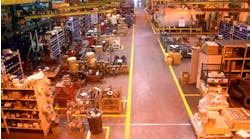Helping people thrive is the key to achieving maximum productivity and ROI, but too many spaces aren’t flexible enough to do that. Learn how raceways help facilities managers reconfigure spaces to support users’ work needs. Mariah Obiedzinski and Janelle Penny discuss solutions and things to think about in your building. Listen now >>
Rather read the transcript?
[Start transcript]
Mariah Obiedzinski: This is Mariah Obiedzinski, senior director of content services for Stamats Communications. And I’m here with Janelle Penny, editor-in-chief of BUILDINGS Media. This podcast was created in partnership with Connectrac. Today, we’re talking about the role wireways play in open office design.
Janelle, what is it about open offices that makes it so hard to plan space effectively?
Janelle Penny: So, there are several things that come into play here. One is that, of course, open offices are all different. You need an open office design that works specifically for your organization. They’re not just off the shelf designs that you can use.
It needs to help people in the space thrive. Companies are trying to maximize productivity and their return on investment from implementing these open office designs. But they can’t do that if the spaces are loud or they’re inflexible or it’s just hard to get work done there. The biggest one is reconfigurability. Spaces need to be able to adapt. You don’t have unlimited square footage in your building, so you need to be able to use one space for several things.
And those different uses might even be very different from each other. Like, you might have a big open lobby or a cafe with different seating and tables in it. And you might decide you’re going to start hosting your all staff meetings there. So, now maybe you need to be able to move the tables out of the way, and you might bring in some kind of auditorium-style seating and some AV equipment for presentation. So, it’s becoming much more important to be able to move things around and reconfigure a space when you need to.
Mariah: Speaking about reconfiguring spaces, isn’t that tough to do in an existing building?
Janelle: It can be. One of the biggest challenges is connectivity. Of course, power and data start at the wall. And an open office layout by definition is a big, open space that might have groups of workstations or other furniture all the way into the middle of the space.
There are some retrofit solutions you can use to run power to new places in an existing building. The two biggest ones being core drilling, where you punch a hole in the concrete and run wires through the ceiling of the floor below you. So, that’s for upper floors. And the other one is trenching, where you’re literally just digging a trench to hold the wires. That’s for the ground floor.
They’re both super effective, but they’re also very disruptive, not to mention really expensive and permanent. And they’re not very flexible either, because of course, the floor can only hold so many holes, so you’re limited for the future.
One other thing that’s been popular are power poles because they can hide the wiring coming down from the ceiling. It’s a big ceiling height pole, and it tends to end up in the middle of workstations because that’s where you need connectivity. But now you have this big visual obstruction, which is kind of annoying when you’re just trying to look around it and talk to your coworker.
Mariah: So, what can building owners and facility managers do about these problems?
Janelle: So, this is where wireways or raceways come in. Both terms referring to a metal trap with either a hinged cover or removable cover on it. And it encloses those wires or cables that would otherwise just be exposed when you’re trying to run them into the middle of a space. And it keeps them out of the way.
Basically, in a nutshell, you either screw them into the concrete slab or use construction adhesive to fasten them down. And you can have an electrical contractor do that, or you can also have your in-house facilities manager do it if they have some electrical training.
Mariah: Why does an owner have to corral those cables? Can’t they just tape them down or put some carpet tiles over them?
Janelle: A lot of people do that. And there are lots of reasons why you shouldn’t, but here’s some of the biggest ones. Press damage is a big problem with that. People are going to walk all over your wiring, and it’s going to get hit with rolling furniture, mobile tech carts and anything else that moves over your floor. So, over time, it’s going to damage your wiring, and you’re going to have to replace it.
It also creates a trip hazard. It’s pretty easy for people walking through a space to just catch their foot on a loose cable or trip over a bundle of stuff that the owner has taped to the floor. A building owner or facility manager knows those liability suits can get very expensive very easily. It’s easier to just not have the problem in the first place.
And also, if it’s big enough to trip someone, and if it’s in an area people are walking through, it’s almost definitely an ADA violation, too. The Americans with Disabilities Act requires any change in height to be no steeper than 1 to 12. That’s one inch of height for every 12 inches of horizontal run.
So, a pile of cables that’s just duct taped to the floor in an area where people are walking definitely doesn’t meet that slope requirement. And a raceway or a wireway has a sloping side that has an even more gradual rise than the minimum requirements. So, it’s barely noticeable when you’re walking and people with mobility aids can walk or roll over it with no problem.
Mariah: Janelle, you have convinced me. So, how do I get started on such a program?
Janelle: First, you need to figure out what your needs are. In other words, name the problem, right? Figure out what you’re trying to solve, and then figure out how to solve it.
You want to do things like think about the alternate uses of each space. What do you use that space for most of the time? What else do you think you might use it for in the future? Sometimes the other uses might affect where you put the furniture or how people navigate their way through that space. And it also might affect how you market the building to people who want to lease space there.
So, really think about how you’re going to be using it and how you might use it differently. And then once you’ve got that in mind, you can start looking at the different options for raceways out there and think about which model is best and where you might place that.
There are a few different options that you can look at depending on what your specific needs are. Some of the biggest ones are models that go under the carpet where it’s almost completely concealed. There are ones that go in the carpet where you see like a thin flat panel where the raceway is. And then there’s one that just goes on the floor where the whole thing is visible, ramping off.
There are different reasons to use the different ones, but you know you’re building best. So, once you familiarize yourself with your options, you can kind of mentally start making a plan of where you might place things.
There are also some modular products out there where you could swap out the power devices pretty easily. And this becomes important when you’re looking at reconfiguring spaces significantly. When you’re reconfiguring the space for a certain use, you might want a different area to have the power receptacle that people plug into. And then for other uses, you might want that receptacle in some other area of the room.
There’s a modular product out there where you can pop the receptacle off and just put like a flat cap over it whenever you don’t need power in that particular space. So, think about hosting something like maybe a yoga class in your multipurpose space. It’s a lot easier to lay that yoga mat over a little flat panel than it is with that round receptacle that makes like a bump in the floor.
Some other things to think about when you want to get started, going back to ADA compliance, remember the problem we’re trying to solve by not having these bundles of cables laying around? You don’t want to trip hazard. You want to look at what kinds of layouts you might have.
Again, this is a good time to bring in the manufacturer because they have design teams who I’m sure have seen it all, so they can make recommendations for you and help you get unstuck if you’re running into trouble.
You want to look at other upgrades you might make in the space, too. If you’re going to renovate anyway to put these raceways in, you might take out some of the older seating or desks and maybe put some powered furniture in there when you’re installing the raceways. That would affect the installation then because it affects how many connections you need to route through there.
So, think about whether you’re going to make any other changes and how they might affect your connectivity needs in any way. And that also means you need to look at the number of cables that you need to run. You can run power and data through the same raceway as long as the device separates them. And you can also join multiple raceways together if you need a lot of connections, but of course, it’s always easier if you know that ahead of time.
Mariah: Where can we learn more, Janelle?
Janelle: Well, you can visit the sponsor of this podcast, Connectrac at Connectrac.com. You can also head to Buildings.com where we’ve created a whole CEU on this exact topic. If you’re looking for continuing education credits or just want to learn more, you can watch a webinar or read a long form article about it to earn a certificate that counts toward several professional certifications.
Thanks to our sponsor, Connectrac, and thanks to all of you for joining me and Mariah today. Have a great day, and we’ll see you again soon.
[End transcript]
Ready to get CEU credits? Get started here or watch the webinar.


